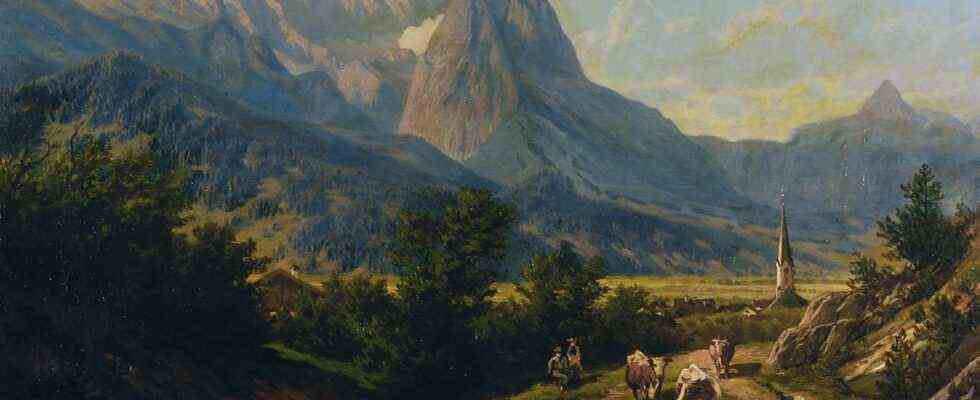In 1883, three years before his death, King Ludwig II acquired the Falkenstein castle ruins on the border with Tyrol. There he wanted to create a romantic fairytale castle that would even surpass Neuschwanstein Castle in size and splendor. The king commissioned Max Schultze (1845-1926), the court architect of the Thurn und Taxis family in Regensburg, with the delicate planning of the castle. He immediately had a water pipe and a path laid out, but the project ultimately remained a dream because of the king’s imminent death.
The fact that Schultze was chosen for this prestigious project shows what an excellent reputation he enjoyed. Today there is no doubt that the native of Partenkirchen, as an artist and architect, left a lasting mark on his era, but, like so many other geniuses, has undeservedly been forgotten.
Max Schultze around 1895, photographed by Bernhard Johannes.
(Photo: Prince Thurn and Taxis Central Archive and Court Library)
For the first time ever, Schultze and his huge life’s work are being honored in an exhibition. Peter Styra, the director of the central archive, the museums and the court library of the House of Thurn und Taxis, has no doubt that Schultze is one of the most important architects and artists in Bavaria. For Styra, he embodies the classic polyhistor that no longer exists today. These were people who were inquisitive, educated, and successful in many fields. Schultze’s universality is reflected in the diversity of the exhibition, for which more than 40 scientists, conservationists, collectors and photographers have compiled their research results as well as paintings, drawings, watercolors, plans, photos and furniture. Camera, paper and pencil were Schultze’s constant companions on mountain tours and business trips to the Thurn und Taxis family estates in Croatia.
Schultze was also a pioneer as a nature and homeland protector. Of course, far too little is known about the homeland security movement that was forming at the time. The Lord Mayor of Regensburg, Gertrud Maltz-Schwarzfischer, reminds in her foreword to the catalog that Schultze acquired eleven plots of land with species-rich grass in 1906, which he donated to the city on the condition not to sell or lease them, nor to turn it into a park.
From 1872 onwards, Schultze worked for the Princely House of Thurn und Taxis for 40 years. “He shaped the castle like no other,” says Styra, who, together with Thomas Feuerer from the Historisches Verein, drew up the plan for an exhibition that will ultimately be realized in a cooperation between the House of Thurn and Taxis, the City of Regensburg, the Historisches Verein and the University of Regensburg has been. Looking back, it becomes clear that Schultze planned everything himself during the construction of the south wing of St. Emmeram Castle, from the doorknob to the roof shingles and furniture. The 165 meter long bar, built between 1883 and 1888, was the last palace to be built in Bavaria and the largest work left by the architect Schultze. Among other things, he also built the Hohenzollern Palace in Munich and the Regensburger Hütte in Val Gardena.
The execution plan of the avenue facade of the 165-meter-long south wing of St. Emmeram Castle in Regensburg, around 1883.
(Photo: Prince Thurn and Taxis Central Archive and Court Library)
The history of the only name certificate that exists about him in Regensburg is also remarkable. On the Danube, Schultze acquired a ridge that was doomed to extinction through limestone mining. He donated these to the city of Regensburg under the stipulation that there should never be any development there. Even today, narrow paths lead hikers on the right bank of the Danube through the “Max-Schultze-Steig” named after him. Today this gem offers a habitat for the rare plants and animals.
In a letter to a friend, he called himself an “apostle for beauty” https://www.sueddeutsche.de/bayern/. “Without a doubt, Schultze described himself aptly with it,” says Styra, because he is not just himself He had been looking for the beautiful in nature, architecture and art all his life, but “he always wanted to open the eyes of his fellow human beings to the beauty of their environment.” Max Schultze was a child of the 19th century, to whom the master builder Karl Friedrich Schinkel once attested that it was shaped by the “discovery of the threatened”. A formulation that also applies to the present and its violent discourses. For this reason alone, says Styra, dealing with the life and work of Schultze is worthwhile. It is simply of too high quality to be forgotten without documentation.
Apostles for beauty. Max Schultze (1845-1926) as an architect, artist, alpinist, nature and homeland protector. City Gallery in the Empty Bag, Regensburg, Bertholdtstr. October 9 to October 3.

